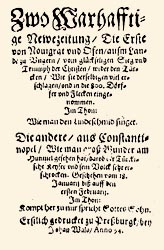A characteristic genre of 16th century printings was the so-called „Newe Zeitung” i.e. a newsletter of some pages informing readers about recent events like wars, battles or miraculous phenomena. As they were issued irregularly they cannot be considered early newspapers, anyway they were the forerunners of today's newspapers. As the majority was in German and circulated in German language area - at least those which reached contemporary Hungary, -- this type of printing was familiar to Hungarian readers as well. Moreover, such newsletters were also issued by Joannes Manlius the printer working at certain sites in Western Hungary.
There is a newsletter with the title Zwo Wahrhaftige Newezeitung which – according to its German text – was printed for the first time in Pozsony (Pressburg, Bratislava, SK) : „erstlich gedrucket zu Preßburgk bey Johan Walo anno 94”. However, a printer called Walo is unknown among printers active in Pozsony or Hungary, or even in Europe. As to the subject of the newsletter, its first part is about the victory won in Hungary by Christian forces over the Osman Turks, therefore it can be supposed that the Hungarian printing place „Pressburgk” (German name for Pozsony) was put on the title page for the sake of authority, but in fact it is a fake. For the time being there is no data at our disposal which would support the assumption that in fact there was a printing press active in Pozsony in the 16th century.
 |
The only printing bearing the name of Johan Walo (RMNy750) |
The expression that can be read on the title page „erstlich gedrucket zu Preßburgk in 1594” very typical for newsletters of the age can be interpreted in two ways: first, meaning that now it is printed in Pozsony for the first time - or, the other way, that it was firsz printed in Pozsony, but now it is reprinted (somewhere else). This type of imprint makes also the date of printing dubious.
The first part of the news are about the siege of Nógrád castle in Northern Hungary, recaptured from the Turks by Hungarian forces, while the second part is about a miraculous phenomena taking place in the same year in Constantinople. The appearence of this comet was first published by Joannes Manlius, the printer mentioned above, in Sicz (Németlövő) in 1593, that is why it was assumed that perhaps it was his printing shop that might have issued the Newe Zeitung with false imprint. However, the printing types used by the two workshops are different. The 4 leaves of Zwo Wahrhafftige ... are printed with a comparatively great variety of types: altogether 8 types, and it rather suggests some printing shop outside Hungary and no identity with Manlius' equipment.
It is also possible that Walo was not a printer but a card-painter or a bookseller - although the comparatively rich variety of printing types and the lack of any decorative element would contradict this supposition. Apart from the dubious imprint there is nothing to prove that it was printed in Hungary -- perhaps its printing types will help to identify the printer's person and the place of printing.


- Printing types - back to the top -


PRINTING TYPES


- back to the top -

LITERATURE:
GULYÁS Pál: A könyvnyomtatás Magyarországon a XV. És XVI. században. Budapest 1931.
KERTBENY Károly: A magyar nemzeti és nemzetközi irodalom könyvészete I. Budapest 1880.
V. Ecsedy Judit: A régi magyarországi nyomdák betűi és díszei. Budapest 2004. (Hungaria typographica 1.)